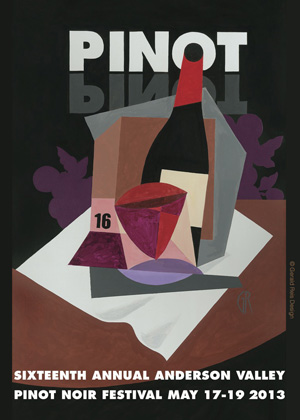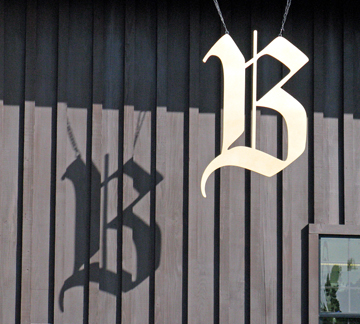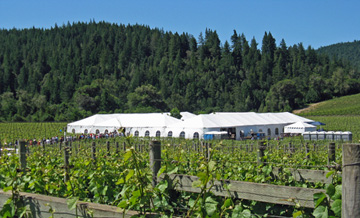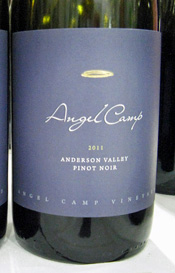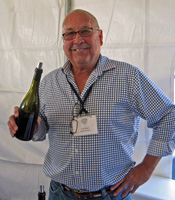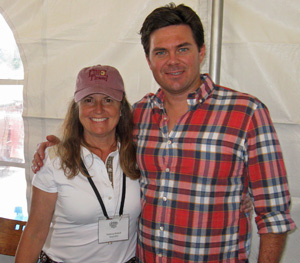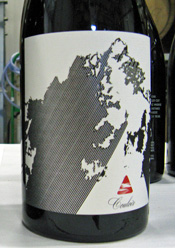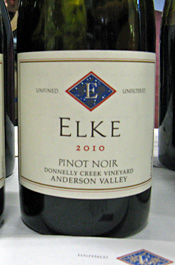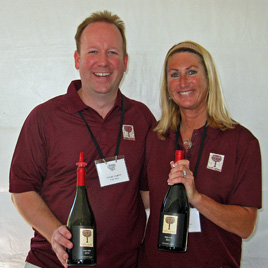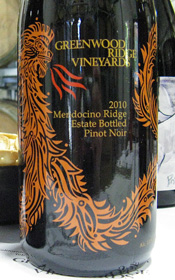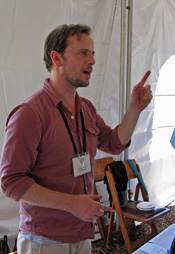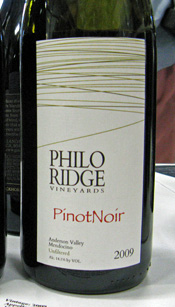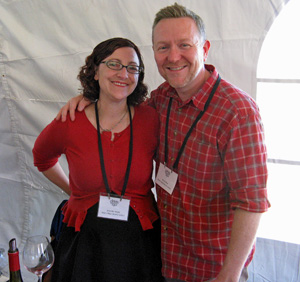Angel Camp Vineyards
Angel Camp 2012 Pinot Noir Blanc, Anderson Valley. Picked early and whole-cluster pressed, made in neutral oak and aged on the lees. Light straw color, this showed stone fruit, cranberry, and spice aromas. Medium-light bodied with a fairly smooth but lively texture and finish.
Angel Camp 2012 Vin Gris of Pinot Noir, Anderson Valley. Light salmon color, with bright cranberry and floral aromas along with a touch of herbs. Medium-light weight with a juicy mouthfeel and finish, nice.
Angel Camp 2011 Pinot Noir, Anderson Valley. From 777, David Bruce, Martini, Pommard, and Swan clones, aged in 40% new oak. Medium-light color, featuring strawberry and cranberry fruit, delicate floral notes, tea leaf, and lots of spice. Medium-light bodied with a bright mouthfeel and good structure, finishing with refined tannins, nice.
Comments: 2011 marked the first vintage for Angel Camp, and proprietor Brian Zalaznick was on hand to pour the wines. Angel Camp Vineyard, in the “deep end” of the valley, was planted in 2006. The Pinot Noir fruit was entirely destemmed. This was a fine debut for this new label.
Balo Vineyards
Balo 2012 Pinot Noir Blanc, Anderson Valley. Whole-cluster pressed immediately with no skin-juice contact, and made entirely in stainless steel. Light straw color, with stone fruit, spice, and floral notes. Bright, juicy mouthfeel with a fresh finish, nice.
Balo 2012 Vin Gris of Pinot Noir, Anderson Valley. Made in 50% each stainless steel and neutral oak. Very light salmon color, with mild strawberry and herb, plus a touch of earth. Lighter-bodied with crisp acidity and a clean finish.
Balo 2011 Pinot Noir, Estate, Anderson Valley. From 777, 828, 115, Pommard, and Martini clones, aged in 30% new oak. Lighter ruby color, this showed bright strawberry, fresh herb, and slightly floral aromas, along with an earthy, forest floor component. Medium-light weight with a fairly smooth texture but finishing with firm acidity and fine, chalky tannins, nice.
Comments: This was my first time tasting the Balo wines, a label founded in 2009 by growers Tim and Michele Mullins. They poured their wines, which are made by Jason Drew, at the event. The estate Balo Vineyard is in the Philo area and was first planted in 1998. It’s farmed organically, though not yet certified. All of these wines were very good.
Baxter Winery
Baxter 2010 Pinot Noir, Valenti Vineyard, Mendocino Ridge. Whole-cluster fermentation. Medium-light garnet color, this was savory and spicy, with red fruits and earth in support. Medium-light bodied with a bright texture and moderate tannins, nice.
Baxter 2009 Pinot Noir, Langley Vineyard, Anderson Valley. From Martini clone vines planted in 1982. Slightly darker color, with black cherry, forest floor, and mineral notes. More weight on the palate than the Valenti bottling, but remaining lively and finishing with bigger but refined tannins.
Baxter 2009 Pinot Noir, Anderson Valley. From a number of vineyard sources including Langley and Oppenheimer. Medium-light color, displaying savory plum and raspberry fruit, dried herb aromas, plus hints of flowers and earth. Medium-bodied with moderate tannins and a long finish, nice.
Baxter 2012 Pinot Noir, Run Dog Vineyard, Anderson Valley (barrel sample). From Pommard clone vines grown at a one-acre site. Medium color, this showed youthful primary raspberry fruit, forest floor, and spice on the nose. Bigger mouthfeel with fairly grippy tannins, this has potential but obviously needs time to develop.
Comments: I continue to be impressed by the Baxter wines. Both Phil Baxter and his son Phillip were on hand at the event. Both father and son studied winemaking (at Cal State Fresno and UC Davis, respectively), and have long backgrounds in the wine business. The Baxter label was launched in 2002. Wines undergo native yeast fermentations, and neutral oak is used for barrel-aging.
Bink Wines
Bink 2011 Pinot Noir, Thomas T Thomas Vineyard, Anderson Valley. Medium-light color, featuring lots of spice and bright plum and black cherry fruit. Medium-bodied with a lively mouthfeel and fairly big, youthful tannins, this shows some promise but will need cellar time to settle down.
Comments: Bink was founded in 2003 by Cindy Paulson and winemaker Deb Schatzlein, who was behind the table pouring her wines. Bink owns noted Hawks Butte Vineyard in the Yorkville Highlands just southeast of Anderson Valley. Thomas T Thomas Vineyard is located adjacent to Toulouse Vineyard.
Black Kite Cellars
Black Kite 2010 Pinot Noir, "Kite's Rest," Anderson Valley. From 114, 115, and Pommard clones. Medium-light color, featuring upfront cherry fruit along with herbs and peppery spice. Medium-bodied with good acidity and a milder tannins on the clean finish.
Black Kite 2010 Pinot Noir, "Redwood's Edge," Anderson Valley. From the highest vineyard block, with 114 and 115 clones. Slightly darker color, this had more earth, spice, and tea leaf aromas with raspberry fruit and a floral note. Bigger and more structured on the palate, with a long and lively finish, nice.
Black Kite 2010 Pinot Noir, "Stony Terrace," Anderson Valley. From a rockier spot in the vineyard, with 100% Pommard clone. Medium-light color, showing more spice and forest floor notes plus plummy fruit. Structured mouthfeel with a grippier tannic finish.
Black Kite 2010 Pinot Noir, "River Turn," Anderson Valley. From the lowest part of the vineyard, with 100% Pommard clone. Medium color, showing a more savory profile with tea leaf and mineral notes along with raspberry, spice, and floral components. Medium weight with bright acidity and more refined tannins.
Black Kite 2011 Pinot Noir, "Kite's Rest," Anderson Valley. From 114, 115, and Pommard clones. A bit lighter color, with cherry and strawberry fruit, flowers, and herbs on the nose. Medium-light bodied with a juicy mouthfeel and fine tannins on the long finish, nice.
Comments: Black Kite was founded in 2003 by Donald & Maureen Green. Their children, Rebecca Green Birdsall, Victoria Green Comfort, and Michael Green, are all now part of the winery team, while Jeff Gaffner is the consulting winemaker. The 12-acre estate Kite’s Rest vineyard was planted in 1999 in the “deep end” of Anderson Valley. The "Kite's Rest" bottling is a blend of the three vineyard blocks that are also bottled separately. The wines are aged in about 50% new oak. This was a very impressive group of Anderson Valley Pinots.
Breggo Cellars
Breggo 2010 Pinot Noir, Anderson Valley. Sourced from Wiley, Savoy, and Donnelly Creek vineyards, aged in 48% new oak. Medium-light color, with raspberry and black cherry fruit, smoky oak, and spice aromas. Medium weight on the palate, with good structure and moderate tannins.
Breggo 2010 Pinot Noir, Ferrington Vineyard, Anderson Valley. From 115, 777, and Wädenswil clones, aged in 56% new oak. Slightly darker ruby color, displaying more earth and mushroom notes along with black cherry, spice, and vanilla/oak. A bit richer mouthfeel but retaining good structure and finishing with refined tannins, nice.
Breggo 2010 Pinot Noir, Donnelly Creek Vineyard, Anderson Valley. From Pommard and Stang clones, aged in 69% new oak. Medium color, this showed plum and darker berry fruit plus spice, earth, vanilla/oak, and an iron/mineral element. Structured mouthfeel with somewhat grippier tannins on the finish.
Breggo 2010 Pinot Noir, Savoy Vineyard, Anderson Valley. From Martini 15, 115, 667, Pommard, and Calera clones, aged in 50% new oak. Medium ruby color, more upfront cherry and plum fruit, along with spice, smoke, and tea leaf notes. Fairly rich, with fine tannins and a long finish.
Breggo 2010 Pinot Noir, “Spiritus,” Savoy Vineyard, Anderson Valley. From Martini 15, 667, and Pommard clones, a barrel selection aged in 100% new oak. Medium color, with more intense aromas of raspberry and plum, forest floor, spice, and vanilla/oak. Medium-rich mouthfeel with a minerally feel and good balance, finishing with fine tannins.
Comments: Breggo’s first vintage was in 2005, and it has been a solid producer from the start. Cliff Lede purchased Breggo in 2009 from founder Doug Stewart and the winery acquired the noted Savoy Vineyard in 2011. Longtime Breggo winemaker Ryan Hodgins poured a good group of wines at the event.
Cakebread Cellars
Cakebread 2011 Pinot Noir, Anderson Valley. Aged in 37% new oak. Medium-light color, this featured lots of spice, raspberry and black cherry fruit, and vanilla/oak on the nose. Medium-bodied and structured in the mouth, it finished with slightly bitter tannins.
Comments: Cakebread’s 46-acre estate vineyard in Anderson Valley was planted to six clones of Pinot Noir in 2001. They also purchased nearby Annahala Vineyard in 2011.
Champ de Rêves Vineyards
Champ de Rêves 2012 Pinot Noir Blanc, Anderson Valley. Light color straw, with pear and spice aromas. Medium-light bodied and relatively smooth on the palate and finish.
Champ de Rêves 2011 Pinot Noir, Anderson Valley. Medium-light ruby color, this was fruit-forward with plum and black cherry notes plus spice, earth, and vanilla/oak undertones. Medium weight in the mouth with a moderately rich finish.
Comments: A new label from Jackson Family Wines, Champ de Rêves – the winery name is French for “field of dreams” – focuses on Anderson Valley Pinot, sourcing their fruit from Boone Ridge Vineyard in the hills above Boonville. The vineyard site, formerly part of the Edmeades property, was planted in 2006 with seven Pinot clones, and the wines are made by Eric Johannsen.
Claudia Springs Winery
Claudia Springs 2009 Pinot Noir, Klindt Vineyard, Anderson Valley. Medium-light garnet color, this showed strawberry and cherry fruit plus plenty of spice, a floral note, and undertones of vanilla/oak. Medium-bodied and lively, with fine tannins on the finish.
Claudia Springs 2010 Pinot Noir, Klindt Vineyard, Anderson Valley. 10% whole-cluster fermentation, Medium-light color, with riper cherry and raspberry, spice, and a touch of oak. Medium weight with juicy acidity on the palate, this had a tingly finish with fairly mild tannins.
Comments: Bob & Claudia Klindt’s winery and estate vineyard is located in the “deep end” of Anderson Valley near Navarro. The vineyard was established in 1998, and is planted to several Pinot Noir clones – Pommard 4 and 5, 113, 115, 667, and 777 – as well as to some Pinot Gris.
Copain Wines
Copain 2010 Pinot Noir, “Les Voisins,” Anderson Valley. Sourced from Hein, Abel, Henneberg, Monument Tree and Kiser vineyards. Lighter color, displaying savory, herbal aromas along with red fruits and earth. Medium-light bodied with a lively texture and mild tannins, quite pleasant.
Copain 2010 Pinot Noir, “Kiser En Haut,” Anderson Valley. From the upper part of the vineyard, on decomposed sandstone and shale soils. Medium-light color, with a stony mineral element plus raspberry fruit, earth, and a slight floral note. Medium weight on the palate with very good structure and balance, finishing with fine tannins, nice.
Copain 2010 Pinot Noir, “Kiser En Bas,” Anderson Valley. From the lower part of the vineyard on rocky clay soil. Slightly darker color, more earthy than the “En Haut” bottling with black cherry and plum in support, along with hints of tea leaf. Bigger and more structured, with a grippier tannic finish.
Copain 2012 Pinot Gris, Klindt Vineyard, Anderson Valley. From keg. Light straw color, with pear, spice, and slightly floral aromas. Lightly sparkling, this had great acidity and a bright, clean finish.
Comments: Wells Guthrie established Copain in 1999. He’s been making Pinot Noir since the beginning, with nearly all the vineyard sources coming from Anderson Valley. Recent vintages have shown a lighter hand than the early ones. All of the Pinots get about 15-20% whole-cluster fermentation. The keg of lightly-sparkling Pinot Gris was behind the table, and I’m not sure whether this will be released or if it’s just a fun in-house wine.
Couloir Wines
Straight Line 2010 Pinot Noir, Mendocino County. Sourced mostly from Monument Tree, Londer, and Roma’s vineyards, plus a little from Oppenlander and Chileno Valley vineyards, about 40% whole-cluster fermentation and aged in 40% new oak. Medium-light color, with herbal red fruits, earth, spices, and black pepper. Medium-bodied and lively with fine tannins, nice.
Couloir 2011 Pinot Noir, Roma’s Vineyard, Anderson Valley. Pommard clone from an 1,850-foot elevation vineyard, about 50% whole-cluster fermentation, aged in 40% new oak. Slightly lighter color, this featured cherry, raspberry and earth aromas along with tea leaf, spice, and a touch of sweet oak. Medium-light bodied but with more structure on the palate and more grip on the finish.
Couloir 2011 Pinot Noir, Monument Tree Vineyard, Anderson Valley. From 115, 667, and 777 clones, about 50% whole-cluster fermentation, aged in 40% new oak. Medium-light color, this had shy aromatics at first but it opened up in a few moments, with bright cranberry and strawberry fruit, flowers and fresh herbs on the nose. Medium-bodied and structured, a spice component came out in the mouth and it finished with moderately big but refined tannins, nice.
Couloir 2011 Pinot Noir, Londer Vineyard, Anderson Valley. From 80% Pommard and 20% 115 clones, made with about 50% whole-cluster fermentation and aged in 30% new oak. Slightly darker color, displaying more intense aromas of plum and black cherry, stemmy/herbal notes, black pepper, and lots of spice. Richer mouthfeel, with a big, tannic finish. A structured Pinot that will need time in the cellar.
Comments: Couloir also makes a very good Marin County Pinot, which I tasted at another recent event. Vintner Jon Grant presented a solid line-up of wines, which are fermented using 40-60% whole clusters. These will all benefit from more bottle age. The Straight Line label is meant for more near-term drinking. These wines show very good early integration of both the whole-cluster and new oak components.
Drew Family Cellars
Drew 2012 Vin Gris, Anderson Valley. Sourced from Valenti and Akin vineyards. Very light salmon color, with fresh strawberry, herb, and floral aromas. The mouthfeel combined some weight and depth with lively acidity and a refreshing finish, nice.
Drew 2011 Pinot Noir, “Gatekeepers,” Anderson Valley. Sourced from 45% Morning Dew, 33% Valenti, 11% Weir, and 11% Middle Ridge vineyards, about 35% whole-cluster fermentation, aged in one- to three-year old barrels. Medium-light color, this was earthy and spicy with raspberry and black cherry fruit plus a floral note. Medium-bodied with an elegant texture and fine tannins.
Drew 2010 Pinot Noir, “Talfryn & Calder,” Anderson Valley. From 48% Balo, 40% Valenti, and 12% Wiley vineyards, using 667, 777, 828, Pommard, and Martini clones, 30% whole-cluster fermentation, aged in 15% new oak. Medium-light color, this featured more upfront plum and darker berry fruit, with spice, tea leaf, and earth in support. More weighty and structured on the palate, with a firm tannic finish.
Comments: Jason Drew poured his wines at the tasting. Jason and his wife Molly moved both their wine focus and their family from Santa Barbara to Mendocino in 2005 – they’re located only about three miles from the ocean in the Mendocino Ridge AVA. They planted their own estate vineyard with eight clones of Pinot Noir in 2011 and expect their first commercial harvest next year
Elke Vineyards
Mary Elke 2012 Pinot Noir Blanc, Anderson Valley. Made in 67% stainless steel and 33% neutral oak. Very light straw color, with bright stone fruit, herb, and lees aromas. Medium-light weight on the palate, with a vibrant texture and clean, crisp finish, nice.
Mary Elke 2011 Pinot Noir, “Croppy Fetcher,” Anderson Valley. The wine name means “sheep dog” in Boontling. Mainly 113 and 115 clones, all free run, aged in 45% new oak. Lighter color, this displayed lightly floral aromas along with red fruits, spice, and undertones of vanilla/oak. Light-bodied and lively, with very mild tannins on the finish, a straightforward but very pleasant Pinot.
Elke 2007 Pinot Noir, Donnelly Creek Vineyard, Anderson Valley. Completely destemmed, aged in 35% new oak. Medium-light color, bright red fruits, herbs, and some forest floor notes. Medium-light texture, with moderate tannins on the finish.
Elke 2009 Pinot Noir, Donnelly Creek Vineyard, Anderson Valley. Completely destemmed, aged in 35% new oak. Slightly darker ruby color than the 2007, featuring more upfront black cherry and raspberry fruit, tea leaf, spices, and a bit of sweet oak. Bigger and more structured than the previous wine, this had a long finish but with more tannic grip.
Elke 2010 Pinot Noir, Donnelly Creek Vineyard, Anderson Valley. From three Pinot clones, entirely destemmed and aged in 35% new oak. Lighter color, this displayed black cherry fruit along earth, smoky oak, earth, and a touch of tea leaf. Medium-bodied with good structure and moderately chalky tannins on the finish, a nice Pinot that should age well.
Comments: The Mary Elke label Pinots are intended to be in a more “New World” style, while the Elke label Pinots (with the blue diamond) are more “Old World.” Mary Elke and her family farm their estate Donnelly Creek Vineyard, located just west of Boonville, planted in 1990 with five Pinot clones. The first wines under the Elke label were from the 1997 vintage, and Matt Evans has been the winemaker there since 2010.
Esterlina Vineyards
Esterlina 2010 Pinot Noir, Esterlina Estate Vineyard, Anderson Valley. Medium-light color, this was spicy and earthy, with black cherry and raspberry notes plus sweet oak. Medium weight on the palate with a moderately-structured texture and firm tannins on the finish. Some short-term time in the cellar should benefit this wine.
Comments: The Sterling family founded Esterlina in 2000 after purchasing Cole Ranch Vineyard – the only vineyard in the tiny Cole Ranch AVA, located in the mountains between Boonville and Ukiah – in 1998. In 2001 they acquired the old Pepperwood Springs Vineyard in Anderson Valley, and they grow Pinot Noir at both estate vineyards. Lynn Krausmann, who had previously been at Williams Selyem, has been Esterlina’s winemaker since 2010.
Expression Vineyards
Expression 2011 Pinot Noir, “39°,” Annahala Vineyard, Anderson Valley. Medium-light color edging toward purple, this had earthy, mushroomy notes along with raspberry and plum fruit. Bigger-bodied, with a fairly smooth texture and milder tannins.
Comments: 60-acre Annahala Vineyard is located between Boonville and Philo and is planted to eight clones of Pinot Noir. William Hill and Dick Wollack are the winery owners, and both Wollack and winemaker Patrick Mahaney have connections with Premier Pacific Vineyards – the sites that PPV developed are the sources of Expression’s fruit. Each wine is named for the latitude of the vineyard site.
Foursight Wines
Foursight 2012 Vin Gris of Pinot Noir, Charles Vineyard, Anderson Valley. Picked early and left on the skins for several hours during pressing, then made entirely in stainless steel. Very light orange/salmon color, with strawberry and herb aromas along with an earthy note. Medium-light weight with a fairly smooth mouthfeel and finish.
Foursight 2010 Pinot Noir, “Zero New Oak,” Charles Vineyard, Anderson Valley. From 114, 115, 777, and Pommard 5 clones, about 30% whole-cluster, all second-year and older barrels. Medium-light garnet color, this had bright floral aromas plus strawberry, cherry, and herbs. Medium-bodied with a lively texture and fine tannins on the tasty finish, nice.
Foursight 2010 Pinot Noir, Charles Vineyard, Anderson Valley. Same clones as the previous wine, about 30% whole-cluster, aged in 40% new François Frères and Remond barrels. Medium color, this had intense cherry and raspberry aromas along with slight floral notes, lots of spice and undertones of vanilla/oak. Medium-bodied with a structured feel on the palate and moderately chalky tannins on the finish, nice.
Foursight 2010 Pinot Noir, “Clone 05,” Charles Vineyard, Anderson Valley. Entirely from Pommard 5 clone, about 30% whole-cluster, aged in 50% new French oak. Medium ruby color, with bold aromatics of ripe black cherry and plum fruit, lots of spice, and notes of black pepper, earth, and vanilla/oak. Richer mouthfeel with a more grippy tannic finish.
Comments: Kristy Charles helped pour her family’s wines, which are sourced from their 15-acre estate vineyard near Boonville, planted in 2001. The Charles family first settled in Anderson Valley in 1943. Kristy and her husband Joe Webb founded Foursight along with Bill Charles and his wife Nancy in 2007. Joe makes the wines, and the Pinots all go through native primary and malolactic fermentation.
Frati Horn Wines
Frati Horn 2010 Pinot Noir, Anderson Valley. From 115, 777, and Pommard clones sourced from Londer, Ridley, and Balo vineyards, aged in 25% new oak. Medium-light ruby color, this displayed bright red fruits along with floral and herbal aromas plus notes of forest floor and spice. Medium weight on the palate with vibrant acidity and refined tannins, nice.
Frati Horn 2011 Pinot Noir, Anderson Valley. Medium-light color, with similar aromatics to the 2010 but a bit more herb and earth components. Bright mouthfeel with a lively texture and a bit firmer tannic finish than the 2010. Needs time to settle down but should be good.
Comments: George and Anne Coughlin are the proprietors of Frati Horn (Boontling for “glass of wine”), in partnership with Jon Phillips of Inspiration Vineyards and Winery. 2009 was first vintage for the winery, and the 2011 Pinot was just recently bottled. This was my first experience with Frati Horn, and I was impressed by the wines, which are particularly good values.
|
Fulcrum Wines
Fulcrum 2011 Pinot Noir, Anderson Valley. From 115 and 777 clones, aged in 29% new Remond barrels. Medium ruby color, with higher-toned, almost candied black cherry aromas along with some earthy, leathery notes. Medium weight on the palate with moderate tannins.
Comments: Fulcrum makes only Pinot Noir, and their first wines were from the 2006 vintage. They produce Pinots ranging from Anderson Valley to the Chalone appellation. The vineyard-designate wines are under the Fulcrum label while appellation wines are under the On Point label. David and Christina Rossi are the winery proprietors.
Goldeneye Winery
Goldeneye 2012 Vin Gris of Pinot Noir, Anderson Valley. Made by the saignée method, from juice in contact with the skins for about 22 hours. Very light salmon color, featuring herbs and ripe strawberries on the nose along with some spice notes. Medium-light mouthfeel with a fairly smooth texture and finish.
Goldeneye 2010 Pinot Noir, Anderson Valley. Harvested over five weeks from seven vineyards (including all four estate vineyards), aged in 65% new oak and 35% second-year barrels. Medium color, this showed lots of spice upfront along with black cherry and plum, earth, and vanilla/oak. Bigger-bodied with a rich texture, this was structured for aging and finished with moderately grippy tannins on the spicy finish, a promising wine that needs bottle age to develop.
Goldeneye 2010 Pinot Noir, Gowan Creek Vineyard, Estate, Anderson Valley. From 70% Mount Eden clone and 30% 777 clone, aged in 65% new oak and 35% second-year barrels. Medium ruby color, with bolder aromas of black cherry and raspberry, spice, and vanilla/oak. Rich texture with fairly big but refined tannins.
Comments: Founded by Dan and Margaret Duckhorn of Napa Valley Merlot fame, Goldeneye has been making Pinot Noir from Anderson Valley since 1997. They now farm four estate vineyards in the valley – The Narrows, Split Rail, Gowan Creek, and Confluence. Michael Fay is the current winemaker, succeeding longtime Goldeneye winemaker Zach Rasmuson in 2012.
Greenwood Ridge Vineyards
Greenwood Ridge 2010 Pinot Noir, Estate, Mendocino Ridge. Medium-light ruby color, this had bright and fruit-forward strawberry and rhubarb aromas along with fresh herbs and touches of earth and spice. Lighter-bodied with juicy acidity, milder tannins, and a fresh, clean finish. Perhaps not as complex as some other wines at the tasting but very tasty, ready to drink now, and a good value.
Comments: One of the oldest Pinot producers in the area, Greenwood Ridge was founded in 1980 by vintner Allan Green. The estate vineyard is at about 1,400-foot elevation off of Philo-Greenwood Road, just six miles from the ocean. The Pinot at the tasting was under a screwcap closure.
Handley Cellars
Handley 2010 Pinot Noir, “Reserve,” Estate, Anderson Valley. From Martini clones, aged in 30% new oak. Medium-light color, showing black cherry and raspberry fruit, earth and mushroom notes, spice, and vanilla/oak. Medium-bodied with good structure and refined tannins. Very expressive of Anderson Valley Pinot.
Comments: Founded in 1982 by winemaker Milla Handley, the estate vineyard near Navarro has been certified organic since 2005. Pinot Noir, Chardonnay, and Gewürztraminer are planted there. Pinot fruit is destemmed prior to fermentation. The 2010 “Reserve” Pinot Noir is just the ninth vintage to have “Reserve” bottling since Handley’s first Pinot in 1989.
Harmonique Wine
Harmonique 2007 Pinot Noir, “Delicacé,” Anderson Valley. Mostly 2A clone from Ferrington Vineyard, plus 777 from Klindt Vineyard and Pommard from Conzelman Vineyard. Medium-light garnet color, with herbal aromas along with bright, slightly higher-toned red fruits, and spice. Medium weight on the palate with moderately chewy tannins on the finish.
Comments: A partnership between Bruce Conzelman and Claudia Springs’ Bob Klindt, Harmonique specializes in Chardonnay and Pinot Noir. Both the Klindt and Conzelman vineyards are located in the cooler “deep end” of Anderson Valley. The first Harmonique Pinots were from the 2002 vintage. Pinots are held back for release longer than at most wineries.
Husch Vineyards
Husch 2010 Pinot Noir, Anderson Valley. 25% whole-cluster fermentation, aged in 25% new oak. Medium-light color, featuring strawberry and cherry, smoky oak, spice, and vanilla on the nose. Medium-bodied with a more structured mouthfeel and a fairly grippy tannic finish.
Comments: Located between Philo and Navarro, Husch is the oldest winery in Anderson Valley – it was established by Tony and Gretchen Husch in 1971. They started growing Pinot Noir at their estate vineyard the same year. The winery has been owned by the Oswald family since 1979. The current proprietors, Zac Robinson and Amanda Robinson Holstine, are the third generation of the Oswald family at Husch, and Brad Holstine is the winemaker.
Knez Winery
Knez 2010 Pinot Noir, Demuth Vineyard, Anderson Valley. 50% whole-cluster fermentation.Medium-light color, with red fruits, forest floor, and spice, with floral and tea leaf undertones. Medium-bodied and lively, with good balance and structure, and find tannins on the finish, nice.
Knez 2010 Pinot Noir, Cerise Vineyard, Anderson Valley. From Martini, David Bruce, Pommard, Wädenswil (2A) and 777 clones, 50% whole-cluster fermentation, aged in 33% new oak. Medium-light ruby color, this had a darker fruit profile along with touches of smoke, spice, and earth. Medium-full bodied with bright acidity and plenty of tannin on the finish, a wine that will need some time in the cellar.
Comments: Proprietor Peter Knez purchased both Cerise and Demuth vineyards a few years ago, and in 2009 he planted the new Knez Vineyard between the two, all located high above Boonville. Cerise Vineyard was planted in 1995 with ten Pinot clones, while Demuth was planted in 1982, with Pommard and Wädenswil clones. Farming of the vineyards is transitioning to biodynamic. Anthill Farms’ Anthony Filiberti is the winemaker and was behind the table at the event.
La Crema Winery
La Crema 2010 Pinot Noir, Anderson Valley. Sourced mostly from Maggy Hawk Vineyard near Navarro plus some from Palmer Vineyard near Boonville, entirely destemmed, 35% new oak. Medium-light color, with black cherry, tea leaf, spice, and earth aromas, with a touch of sweet oak. Medium-bodied and lively with fairly mild tannins on the pleasant finish.
Comments: One of the mainstays of Jackson Family Wines, La Crema has been a consistent Pinot producer for quite awhile, and their Sonoma Coast bottling in particular has been a good value. Melissa Stackhouse had been the winemaker there for some years, but left in 2011 – Elizabeth Grant-Douglas took over the winemaking duties at that time.
Lichen Estate
Lichen 2012 Pinot Noir, Anderson Valley (barrel sample). From Martini, 2A, 667, and Pommard clones. Medium-light color, featuring upfront black cherry and raspberry fruit, earth, and spice. Medium-bodied with good balance and milder tannins, a promising young wine that needs more time to develop.
Comments: The 2012 Pinot will be Lichen’s first release. The winery was established by Doug Stewart, who had formerly founded Breggo Cellars but sold that business a few years ago. Lichen has a recently-planted estate vineyard with densely-planted Pinot Noir and Pinot Gris, and Doug plans to produce both still and sparkling wines. Doug was on hand to pour his wine at the event.
Londer Vineyards
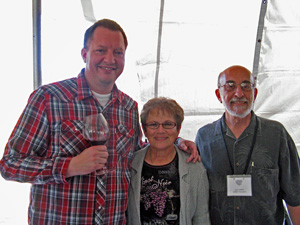 |
| (l to r) Fred Schoeneman (Ferrington Vineyard) with Shirlee and Larry Londer |
Londer 2010 Pinot Noir, Estate, Anderson Valley. Medium-light color, this had herbal red fruits, spice, and touches of forest floor and vanilla/oak on the nose. Medium-bodied with vibrant acidity and moderate tannins.
Londer 2009 Pinot Noir, Estate, Anderson Valley. Slightly lighter color than the 2010, showing more earth and tea leaf aromas along with black cherry, spice, and undertones of sweet oak. Bigger and more structured than the 2010, this had a long finish with refined tannins, nice.
Londer 2010 Pinot Noir, “Paraboll,” Anderson Valley. Sourced from Ferrington and Valley Foothill vineyards, 40% new oak. Medium-light color, with more fruit-forward aromas of black cherry and plum, along with earth, lots of spice, and sweet oak notes. Richer mouthfeel with nice texture and moderate tannins, a bolder style that could use some time in the cellar.
Londer 2010 Pinot Noir, Anderson Valley. Poured from magnum. Sourced from several vineyards. Medium-light ruby color, displaying brighter red fruits, spice, earth, and dried herbs. Medium-bodied and lively on the palate with somewhat grippy tannins on the finish.
Comments: Larry and Shirlee Londer’s estate vineyard near Philo was first planted in 2001 and is mostly Pinot Noir along with a little Gewürztraminer. The Pinots are typically aged in about 30% new oak with a bit more for the “Paraboll” bottling. Larry and Shirlee poured their wines along with Joe Webb, who oversees the vineyard management and winemaking. After a 12-year run of producing some very fine wines, Larry and Shirlee recently announced that they are closing down the winery as of the end of May.
Lula Cellars
Lula 2010 Pinot Noir, Anderson Valley. Sourced from five clones from Middle Ridge Vineyard. Medium color, aged for 18 months in 50% new oak. Medium ruby color, with aromas of black cherry and plum, along with spice and sweet oak. Fairly rich texture with good acidity and a firm tannic finish.
Comments: Lula is the project of veteran Mendocino winemaker Jeff Hansen. He owns a 15-year old vineyard in Comptche, a few miles north of Anderson Valley, and more recently bought property in the Philo area.
MacPhail Family Wines
MacPhail 2010 Pinot Noir, Wightman House Vineyard, Anderson Valley. From 100% Martini clone, entirely destemmed, aged in 50% new oak. Medium-light garnet color, with delicate floral and herbal aromatics along with ripe red fruits and nicely-integrated vanilla/oak. Medium-bodied with a smoother texture and a spice component coming out more in the flavors, finishing with moderate tannins, nice.
MacPhail 2011 Pinot Noir, Anderson Valley. To be released this fall. Medium color, this displayed riper plummy fruit along with earth and smoky oak notes. Medium weight on the palate with a fairly smooth texture and fine tannins.
Comments: Grower/winemaker James MacPhail launched the winery in 2002, and makes Pinots from both Anderson Valley and the Sonoma Coast. Pinots all undergo native primary and malolactic fermentation. Wightman Vineyard is near Boonville, while MacPhail’s new energy-efficient production facility is just outside Healdsburg.
Navarro Vineyards
Navarro 2012 Rosé of Pinot Noir, Anderson Valley. From fruit picked especially for Rosé. Light pink color, this featured bright and fresh strawberry and herb aromas. Lighter-bodied with a vibrant mouthfeel and a crisp, clean finish, nice.
Navarro 2010 Pinot Noir, “Méthode à l'Ancienne,” Anderson Valley. Medium-light ruby color, with herbal and savory aromas upfront, along with raspberry, earth, and touches of black pepper and sweet oak. Medium-light bodied and lively, with fine tannins, nice.
Navarro 2009 Pinot Noir, “Méthode à l'Ancienne,” Anderson Valley. Medium-light color, this was more fruit-forward than the 2010 bottling, with red fruits, tea leaf, plus pepper and spice notes. Medium weight on the palate with a more structured mouthfeel and finish.
Navarro 2007 Pinot Noir, “Méthode à l'Ancienne,” Anderson Valley. Medium-light garnet color, featuring herbs, earth, and black cherry on the nose. Medium-bodied with a smoother texture and more resolved tannins on the finish.
Comments: One of the earlier modern Anderson Valley wineries, Navarro was founded by Ted Bennett and Deborah Cahn. In 1974, they began planting their estate vineyard near Philo with Gewürztraminer, Pinot Noir, Riesling, Muscat, and Chardonnay. Winemaker Jim Klein has been at Navarro since 1992. The “Méthode à l'Ancienne” Pinots are typically aged in around 40% new oak. They tend to age very well and are fine values too.
Nelson Hill Winery
Nelson Hill 2009 Pinot Noir, Anderson Valley. Sourced from 114, 115, and 777 clones, aged in 50% new oak. Fairly light garnet, this had higher-toned red fruits, smoky oak, and spice on the nose. Medium weight on the palate with a slightly chewy tannic finish.
Comments: Nelson Hill is located in the Philo area, and fruit for the 2009 Pinot came entirely from Deep End Vineyard near there.
Phillips Hill Winery
Phillips Hill 2011 Pinot Noir, “Two Terroirs,” Anderson Valley. Sourced from 70% Cerise Vineyard (115, 2A, Pommard clones) and 30% Ridley Vineyard (777 clone), some whole clusters, aged in 30% new oak. Light garnet color, displaying strawberry and cherry fruit, spice, smoke, and earth aromas. Lighter-bodied with a somewhat thin texture, the finish was initially smooth but moderate tannins sneaked up at the end.
Comments: Founded in 2002 by vintner Toby Hill, the winery is on Greenwood Ridge west of Anderson Valley. The “Two Terroirs” bottling blends fruit from the hillside Cerise Vineyard and valley floor Ridley Vineyard. A Phillips Hill estate vineyard is in the planning stages.
Philo Ridge Vineyards
Philo Ridge 2011 Rosé, Anderson Valley. Whole-cluster pressed, with about five hours of juice-skin contact. Light salmon color, this showed lemonpeel and slightly higher-toned strawberry fruit, along with a slight herbal note. Fairly smooth texture and finish.
Philo Ridge 2009 Pinot Gris, Marguerite Vineyard, Anderson Valley. Sourced from 25+ year old vines, made mostly in stainless steel. Light straw color, with bright and floral stone fruit and spice aromas. Moderately rich and smooth on the palate, this finished with a touch of sweetness.
Philo Ridge 2009 Pinot Noir, Anderson Valley. From 115, 667, 777, 2A, and Pommard clones sourced from Ferrington and Philo Ridge vineyards, entirely destemmed, aged in 35% new oak. Medium-light to medium ruby color, this featured earth and forest floor notes along with strawberry and tea leaf, plus touches of spice and vanilla/oak. Medium-light bodied with a bright, juicy mouthfeel, and refined tannins on the clean finish, nice.
Philo Ridge 2010 Pinot Noir, Anderson Valley. From the same sources and made similarly to the 2009. Medium-light color, displaying red fruits, spice, earth, and a background of sweet oak. Medium-bodied with a structured mouthfeel and moderately grippy tannic finish.
Comments: Philo Ridge proprietors Fred Buonanno and Heather McKelvey purchased the vineyard and winery site of the old Christine Woods Winery in 1999, and Norman Kobler directed new plantings there in 2000. Heather is the winemaker, and the first Philo Ridge wines were released in 2004.
Roederer Estate
Roederer 2009 Pinot Noir, Estate, Anderson Valley. Sourced from seven Pinot clones from several blocks of the estate vineyard, 100% destemmed. Medium color, with upfront red fruits along with spice and vanilla/oak aromas. Medium-light weight on the palate with moderately chewy tannins.
Comments: Roederer started developing its Anderson Valley estate vineyard in 1982 and produced its first sparkling wine from there in 1988. Arnaud Weyrich is the winemaker. Known primarily for their sparklers, Roederer also produces a small amount of still Pinot Noir.
Scharffenberger Cellars
Sharffenberger 2007 Pinot Noir, Anderson Valley. Includes fruit from six vineyards and nine Pinot clones, entirely destemmed, aged in 20% new oak. Medium-light garnet, showing higher-toned plum and raspberry, somewhat funky leather and earth notes, and spice. Medium-bodied with a fairly tannic finish.
Comments: John Scharffenberger established his eponymous label in 1981, and it’s been owned since 2004 by Maisons Marques & Domaines, which also owns Roederer Estate. Like Roederer, Scharffenberger is known for its sparkling wines but makes a little still Pinot Noir as well. Tex Sawyer has been the winemaker at Scharffenberger since 1989.
Toulouse Vineyards
Toulouse 2009 Pinot Noir, Estate, Anderson Valley. From 115, 667, 777, and 2A clones. Medium-light color, this featured smoky and earthy aromas, black cherry and plum, and a strong resiny oak element. Medium weight with a slightly hot finish and moderately chewy tannins.
Comments: Vern and Maxine Boltz are the proprietors of Toulouse, and their first wine came from the 2002 vintage. Their estate vineyard is located just outside of Philo.
Twomey Cellars
Twomey 2011 Pinot Noir, Anderson Valley. Sourced from Ferrington and Monument Tree vineyards, aged in 40% new oak and 60% one year-old barrels. Medium-light ruby color, with black cherry, vanilla/oak, spice, and earth on the nose. Richer mouthfeel with good structure and a lively, moderately tannic finish. On the bigger side for Anderson Valley Pinot but nicely done in its style.
Comments: Raymond Twomey Duncan, who co-founded Silver Oak Cellars with Justin Meyer in the early 1970s, launched the Twomey label in 1999. Pinot has been part of the winery’s program since nearly the start, and Twomey’s first Anderson Valley Pinot came in 2007. The winery purchased Monument Tree Vineyard in 2010.
Waits-Mast Family Cellars
Waits-Mast 2010 Pinot Noir, Londer Vineyard, Anderson Valley. From 50% each 115 and Swan clones, entirely destemmed, aged in 30% new oak. Medium-light ruby color, with restrained aromatics that opened up with air, revealing raspberry and black cherry fruit, spice, earth, and a stony mineral note. Medium weight with a lively mouthfeel and fine tannins on the finish, nice.
Waits-Mast 2010 Pinot Noir, Wentzel Vineyard, Anderson Valley. Organically-farmed vineyard, from 114, 115, 667 and 777 clones,entirely destemmed, aged in 25% new oak. Slightly darker color, this showed riper black cherry and plum, spice, and a touches of dried herbs and sweet oak. Bigger and more structured on the palate, with more grip on the finish – this will need time in the cellar.
Comments: Jennifer Waits & Brian Mast established their winery in 2005, and they focus solely on Pinot Noir, mostly sourced from Anderson Valley and nearby Comptche. The wines are made in San Francisco, and grapes are fermented with native yeasts.
Williams Selyem Winery
Williams Selyem 2007 Pinot Noir, Ferrington Vineyard, Anderson Valley. Clones include 115, 667, 777, and Pommard, aged in 70% new oak. Medium-light color, featuring earthy cherry, spice, and a background of vanilla/oak. Medium weight with a bright mouthfeel and moderate tannins. A somewhat bolder style but still expressive of Anderson Valley fruit, this wine seems ready to drink now.
Comments: Sarah Schoeneman and her husband Guy Pacurar poured this wine – Sarah’s parents Kurt and Heather Schoeneman own Ferrington Vineyard. Sarah’s brother Fred was also at the Pinot Festival.
Wind Racer Wines
Wind Racer 2009 Pinot Noir, Anderson Valley. From 667, 777, and 2A clones, destemmed, aged in 34% new oak. Medium-light color, featuring very spicy aromas along with raspberry and vanilla/oak. Moderately rich with good structure and a somewhat grippy tannic finish.
Comments: Barbara Banke and Peggy Furth launched the Wind Racer label in 2006 – it’s part of the Jackson Family Wines portfolio. They produce Chardonnay and Pinot from Anderson Valley and Russian River Valley.
Witching Stick Wines
Witching Stick 2011 Pinot Noir, Cerise Vineyard, Anderson Valley. From 2A, 115, Martini, and Pommard clones, with some whole clusters and some stems added back to the fermentation, and aged in 40% new oak. Medium-light ruby color, showing bright red fruits, a somewhat stemmy/herbal quality, with earth and oak notes. Medium-light bodied, this had juicy acidity and fine tannins on the long finish. Some bottle age should help integrate the components of this wine better, but it’s quite nice even now.
Comments: Witching Stick is the project of longtime Edmeades winemaker Van Williamson and partner Anne Fashauer. The first wines released from this new label were from the 2010 vintage, and the 2011 Cerise Pinot had been bottled in March. The wine underwent native primary and malolactic fermentations.
Zina Hyde Cunningham Winery
Zina Hyde Cunningham 2011 Pinot Noir, Anderson Valley. Medium-light color, this displayed riper cherry, raspberry, and plum fruit, vanilla/oak, and spice. Medium weight on the palate with a fairly smooth texture and moderate tannins.
Comments: The winery was founded in 2004 by Bill Cunningham and his cousin, winemaker Steve Ledson. The Cunningham family’s history with winegrapes in Mendocino County goes back to Bill’s great-grandfather, Zina Hyde, who planted a vineyard in the Ukiah area in 1865.
|


